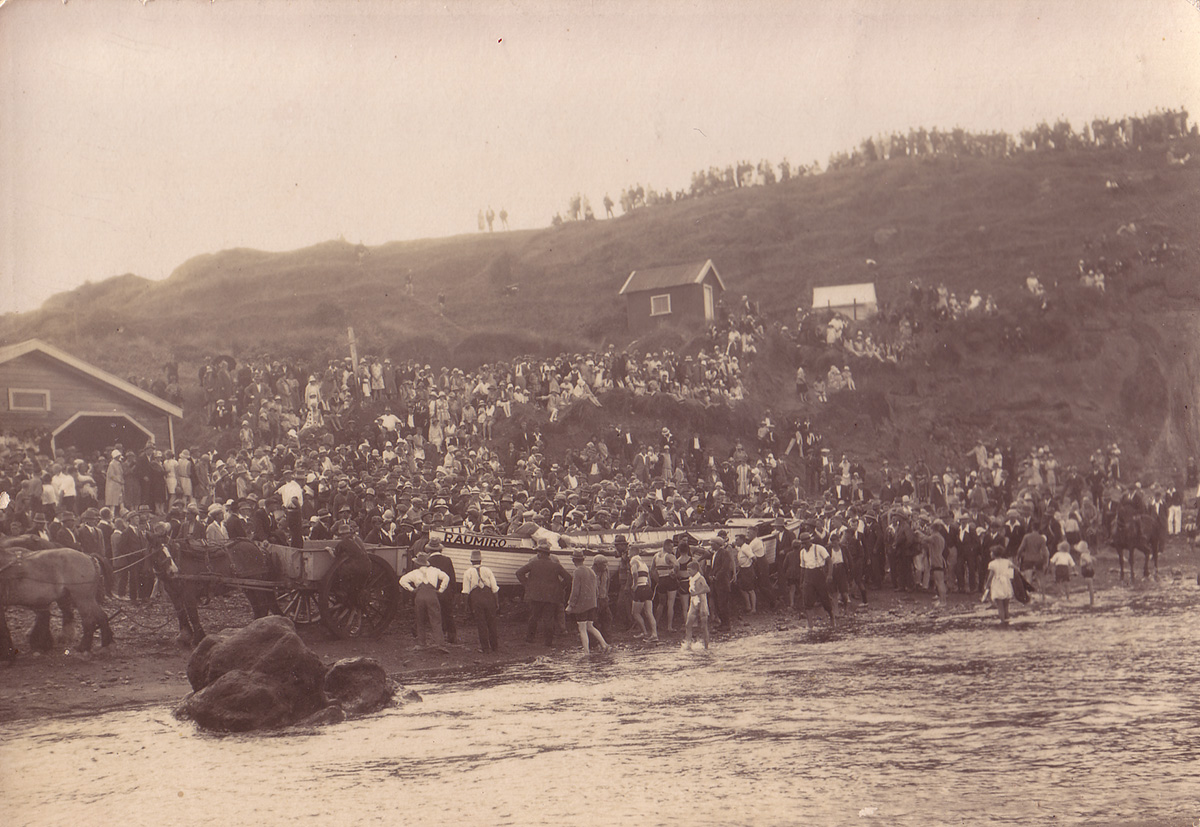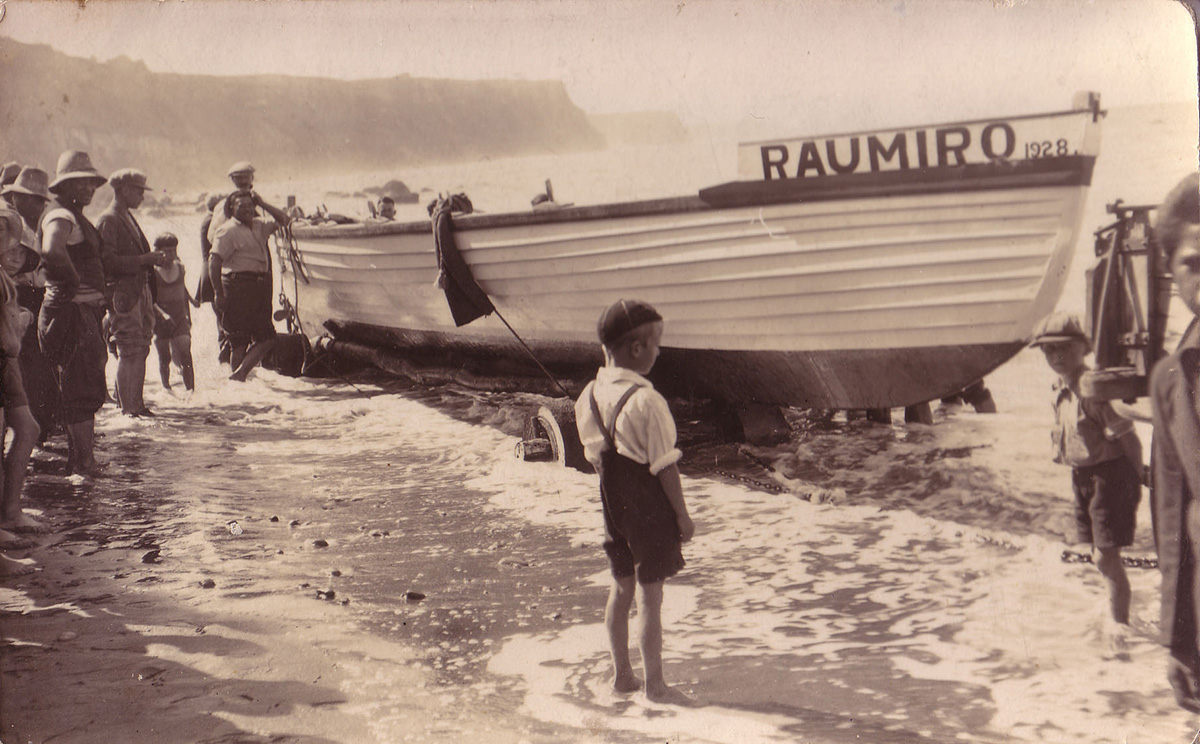



Back in 1927, members of the Ohaku hapū of Ōhawe dreamed of building a motorised fishing boat so they could make fishing trips off the south Taranaki coast. Though the hapū were almost self-sufficient, with good gardens producing excellent crops, it was decided a good seaworthy boat would keep them supplied with kai moana throughout the year. They were particularly fond of shark, which they knew they could smoke cure and store for future times.
The hapū decided they would build their own waka, a canoe big enough to carry at least a dozen fishermen to sea.
Mr Raha, when he was called on to build it, designed a long double-ended whaler, with a wide beam, and a keel hewn from a single log. He expected to find the right tōtara he needed in the nearby bush. Though he and his friend Mr Ripine, and two other helpers, searched the district far and wide, they came up empty-handed.
With no tōtara within easy carting distance, they determined to find a rimu instead, as they were close by and plentiful. Eventually, a large rimu was found, cut down and carted to Mr Raha's property at Ōkaiawa.
There, slowly but surely, a keel took shape as the axes and adzes flew and the wood chips piled up below. Using Oregon pine for ribs and side planks, the boat grew to be 11.3 metres long with a 2.4m beam.
After being fitted out with ten oar blocks and a 22 horse-power ‘Hup’ motor, grunty enough to clear the rocks on the beach, the vessel was painted bright white with sea-blue trimmings and christened the Raumiro.
On 19 February 1928, at 7.15am, mounted on a four wooden-wheeled trailer and drawn by a team of horses, the Raumiro left Ōkaiawa and travelled down Ahipaipa, Scott, South and Ōhawe Roads to the sea. High tide was due at 10am.
Down at Ōhawe Beach, people piled onto the embankment next to the Rangatapu pā and swarmed onto the sand, so they would not miss a word from the guest speakers. Don Glass of Hāwera was six when he joined his parents and around 1000 spectators eager for the boat to appear. He remembers the day as one of great excitement. "In the photos, I'm standing in the crowd up on the bank with my mother, and dad was standing behind the boat, with his hat on. It was a great occasion.”
As the boat came slowly down the road to the beach, Bill Hayward steadied his team of four draught-horses, as he waited with a two-wheeled dray to haul the boat along the shore.
It was Bill Hayward's job to deliver it to the boatshed at the mouth of the Waingongoro, where it would be readied for its first fishing trip. The boat shed, built on rising ground near the river by Mr Ripine and others of the hapū, housed a winch named Aorangi, for hauling the boat up the ramp.
Mr Raha's brother, Mr Piki, thanked the great gathering of people who had come to witness the launch. Though the address was offered in te reo Māori, Charlie Haddon was there to translate it into English. Next came Mr Raha and then H.G.Dickie, MP for Pātea.
Finally, Gate Ekau led a rowdy procession towards the river, with women following behind the Raumiro, chanting a special verse:
“Haul the canoe
Pull the canoe
To the pillar, the canoe
To its bed, the canoe
To it's resting place, the canoe”
Don Glass says Gate Ekau had terrific strength and could lift great weights, and would become a key player when it came to launching the boat. "He had legs like lampposts and he could put a coin in his mouth and fold it over with his teeth."
In the crew that first day were Raha (Captain), J.Raha (Engineer) with Ripine, Peter Luke, J. Ranui, Piki Teki, J. Ngatai, Poteroa Waka, Rakei Tamata, Wi Hawe, Rangi Ruru, Ngati Wetere and Peter Peterson.
Soon, the boat was pushed through the foam where it sat on the horizon for several hours. When it came back to shore, Mr Raha carried the first fish and Mr Ripine the anchor stone, taking them up river out of sight to bury them where no one would find them. According to Māori customs, they were gifts to the god of the sea.
Aside from one minor mishap on 3 March that same year, when the boat hit the rocks and damaged some planking, the Raumiro and her crew sailed safely and well for many years.
The boat was usually crewed by both Māori and Pākehā. Glass says his father often went fishing in the huge canoe. "Dad got on very well with the Māori people. I went with him to Ōhangai when he helped build the meeting house. He was a carpenter, and he learnt a bit of Māori."
He says the fishermen really only wanted sharks. It was not unusual for the iwi to swap a snapper for a shark, given the opportunity. "They would clean them and hang them in the smoke room then they'd use them as they wanted them."
On 31 May 1934, a party of 12 Māori and two Pākehā went out at dawn. Though they were expected back just after sunset, around 9 o'clock, the Raumiro failed to return.
At midnight, the alarm was raised. When the Hāwera police were notified, Constable Pidgeon kept a vigil from the beach, along with concerned Ōhawe citizens. But it wasn't until early the next morning that a plane could be sent to find the missing men.
Brian Haybittle and Brian Davies, aboard a ZK-ABS, finally spotted the Raumiro nearly 7 kilometres from shore. Though the rowers had worked the oars all night, the tide and high wind had turned against them, and they had made slow progress.
Despite the bad weather conditions, Haybittle flew his plane as low as possible, dropping food to the men. He made three trips out with provisions, including petrol for the engine, but the motor refused to start and the luckless sailors were left to continue rowing towards the shore.
(Haybittle, a good pilot and mechanic, would later go down in a Fox Moth plane that crashed into the Pātea River. Though it claimed the lives of his passengers, Messrs Meuli and Maule, amazingly, Haybittle survived.)
Guided by the tiny flames, the Raumiro came ashore. "They stayed out all night and rowed back the next day," Glass says. "It was a hefty boat to row. It weighed quite a bit."
But despite a safe landing and no loss of life, the fishermen had lost all confidence in their boat and wouldn't risk the sea in it again. The Raumiro was dragged up the Waingongoro, not far from the river mouth or the boatshed and left there.
As Don Glass explains: "They weren't prepared to go out in it again. They put a tapu on it. That's their custom. They put a tapu on it and it's underneath the sand. It was their boat. They wouldn't sell it. I used to see it there, lying in the sand. Then the sand built up because the coast is pretty treacherous."
Eventually, the proud Raumiro disappeared beneath the sand. And that's where she lies today, lost to the riverbed, with only photos to prove she was ever built at all.
Search the Puke Ariki Heritage Collection
LinkPlease do not reproduce these images without permission from Puke Ariki.
Contact us for more information or you can order images online here.